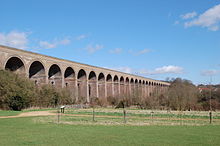- Chappel
-
For the surname, see Chappell.
Chappel is a village in Essex which sits on the River Colne. It is famous for its Victorian viaduct that crosses the Colne valley.
Coordinates: 51°55′03″N 0°45′09″E / 51.9175°N 0.7525°E
Chappel
 Chappel shown within Essex
Chappel shown within EssexPopulation approx 400 OS grid reference TL895279 District Colchester Shire county Essex Region East Country England Sovereign state United Kingdom Post town Colchester Postcode district CO6 Dialling code 01206 2 and 01787 2 Police Essex Fire Essex Ambulance East of England EU Parliament East of England UK Parliament Harwich and North Essex List of places: UK • England • Essex Contents
Name and history
The present name of Chappel derives from the construction of a small church, noted in 1285 AD as standing at the northern boundary of the parish of Great Tey.[1] During the 16th century, due to concerns from Chappel residents about the distance to Great Tey's own church at festival time, this area was split from the parish[2] and become a separate entity known as Pontisbright (lit. "Britric's bridge") that would eventually become known as Chappel.[1]
In 1433 the vicar of Great Tey agreed that the inhabitants of Chappel could find and elect their own chaplain. The benefice itself was united with that of the neighbouring village of Wakes Colne in 1938.[2]
Chappel Viaduct
The Chappel viaduct is 1,066 feet (325 m) long, has 32 arches of 30 feet (9 m) span and its maximum height is 75 feet (23 m). It currently takes the Marks Tey to Sudbury branch line, which connects regularly with trains to and from London's Liverpool Street Station.
The large number of construction workers needed for the project were housed, many with their families, in temporary huts built on Wakes Colne Green. Although some 5 or 6 million bricks are reckoned to have been used, the piers were hollow to save money and reduce weight. A further remarkable feature of the viaduct is that it is built on a gradient - the Sudbury end is 9.5 feet (2.9 m) higher than the Marks Tey end. According to William White’s History, Gazetteer and Directory of the County of Essex, 1848, the first stone was laid in September 1847. The viaduct took two years to build, and is thought to be the second largest brick-built structure in England.[3]
The first passenger train to Sudbury, carrying an official party from Colchester, ran on 2 July 1849.[4]
Village amenities
The village has a pub dating from the 13th century, a parish church, a United Reformed church, a post office and general store, village hall and a railway station, Chappel and Wakes Colne station, which houses the East Anglian Railway Museum. It also has a children's play area which was upgraded in 2007/08 by Chappel Parish Council.
In celebration of the millennium, The Chappel Millennium Green was opened. The Millennium Green has two areas - a nature reserve with board walk, and a mown grass area for general recreation which is bordered by a gravel path. It has also hosted several events, including the burning of a beacon, and Colne Valley Festival events.
Village sign
Chappel's village sign depicts a bridge crossing a river, symbolic of the old bridge, dating from 1140 AD, which crossed the river Colne and connected the two halves of the estate of Crepping Manor. The lord of the manor was, at that time, responsible for its upkeep.[1]
Notable former residents
- Margery Allingham (1904 - 1966), author of fiction - mainly crime and mystery novels.
- Al Barnes (born 1968), former guitarist in the seminal Black Metal Band Venom.
References
- ^ a b c Stratford, Ian (1999). Lost: Chappel and Wakes Colne. Back cover.
- ^ a b "Chappel: Church". A History of the County of Essex: Volume 10: Lexden Hundred (Part) including Dedham, Earls Colne and Wivenhoe. 2001. http://www.british-history.ac.uk/report.aspx?compid=15173. Retrieved 2009-04-14.
- ^ "BBC Seven Wonders". http://www.bbc.co.uk/england/sevenwonders/east/chappell_mm/index.shtml.
- ^ Anderton, Michael (August 2003). "Sudbury". http://www.anderton.btinternet.co.uk/eadtwalk/sudbury.htm.
External links
Categories:- Villages in Essex
- Colchester
Wikimedia Foundation. 2010.


